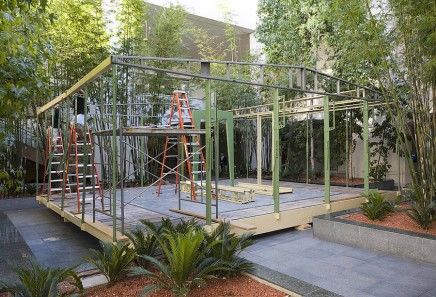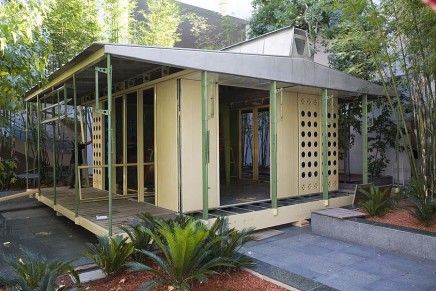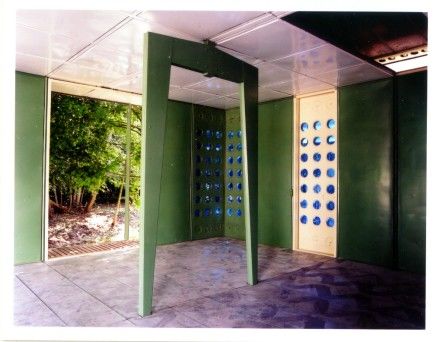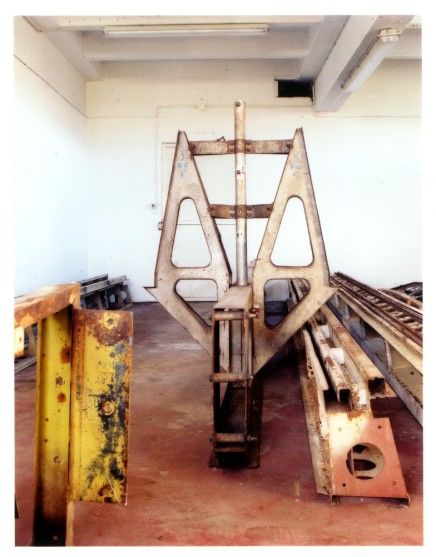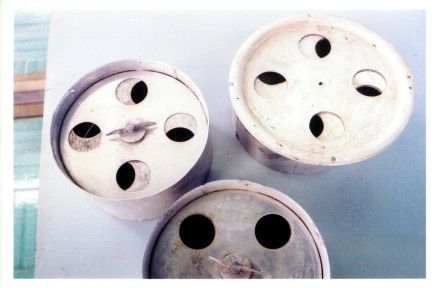
Jean Prouvé
- – This is a past exhibition
Extended! — Due to its popularity, the Tropical House will remain on view at the Hammer Museum through the holidays.
A prefabricated metal house constructed by French designer Jean Prouvé, known as the Tropical House, will be installed in the Hammer Museum courtyard during October and November 2005. Installation of Jean Prouvé: A Tropical House will begin on October 4, and deinstallation will begin in January, 2006. The installation and deinstallation periods will last for approximately two weeks and are integral aspects of the display, allowing the public to observe, first-hand, Prouvé’s notions of prefabricated architecture in practice.
Prouvé designed the Tropical House in 1949 as a prototype for inexpensive, readily assembled housing that could be easily transported to France’s African colonies. Fabricated in Prouvé’s French workshops, the components for the house were completed in 1951 and were flown disassembled to Africa in the cargo hold of an airplane. The house was erected in the town of Brazzaville, Congo, where it remained for nearly 50 years. In 1999, the Tropical House was disassembled and shipped back to France for restoration.
Organized by Robert Rubin.
Related Exhibitions
The Museum of Contemporary Art, Pacific Design Center
Jean Prouvé: Three Nomadic Structures
August 14 – November 27, 2005
An exhibition featuring furniture, architectural elements, and photographs relating to three prefabricated Prouvé buildings—the Glassmaking School in Croismare, France, the Tropical House for Brazzaville and Niamey, Africa, and the Aluminum Centenary Pavilion in Villepinte, France.
For more information visit www.moca.org.
Small Space Gallery, Perloff Hall, UCLA
Jean Prouvé: Drawings and Photographs of A Tropical House
October 17 – December 9, 2005
An exhibition exploring Prouvé’s lightweight-metal building system for the Tropical House through drawings, photographs, and construction materials. Components of the Tropical House will be displayed in the Perloff Hall courtyard.
For more information visit www.aud.ucla.edu.
Essay
By Robert Rubin
For nearly five decades, the French designer and constructeur Jean Prouvé (1901–84) built prototypes for industrialized building systems and pioneered architectural applications of steel aluminum and plastic. The son of a founder of L’École de Nancy, an industrial guild of the nineteenth and early-twentieth centuries, Prouvé grew up in a culture of craft and collaboration that fed a deep artisanal engagement with materials. Moreover, he trained as an ironworker, not as an architect or engineer. While today he is best known for his furniture designs, he made significant contributions to iconic twentieth-century buildings. His work in and around Nancy quickly led to significant commissions from Rob Mallet-Stevens, Le Corbusier, and other leading modernist architects. As he created ironwork for the most expensive private residences in Paris, Prouvé began his lifelong engagement with the industrialization of architecture, particularly its application to mass housing.
For example, when the French government announced the initiation of paid vacations for workers, Prouvé responded with the BLPS (1937–39), a prefabricated steel vacation home. Weighing less than two tons, the 3.3 square meter ( 35.5 square feet) structure could be put up or taken down by five workers in four to five hours. As World War II loomed, Prouvé made barracks for the French army, which prefigured his later housing for the wartime homeless. With the outbreak of war, in collaboration with Le Corbusier and Pierre Jeanneret, he conceived of Écoles Volantes (“flying schools”) for war refugees, with classrooms and dining facilities on the ground floor and dormitories upstairs. After the war he developed a more elaborate prefabricated steel house project, the Stahlhaus, with such highly evolved details as sliding windows that disappear into pockets.
Prouvé accumulated a wide range of patents whose revenue enabled him to start a workshop in Maxéville, on the outskirts of Nancy, in 1947; within six years he employed more than 200 people. At Maxéville, he developed a lightweight metallic building system intended to construct schools, vacation camps, and other public buildings, as well as housing. Maxéville allowed Prouvé to put into practice his theories of the constructive process and the industrialization of architecture: designing and building cannot be separated. Distinctions between architect, engineer, and builder fold into the figure of the constructeur.
Among his achievements at Maxéville was the Tropical House—perhaps the ultimate iteration of his lightweight metal building system. In 1949, Prouvé was given a contract by the Ministry of Reconstruction and Urbanism to build a 14-lot subdivision at Meudon, just outside Paris, to demonstrate his prototype lightweight prefabricated metal building system. The same year, the idea of exporting a tropical variant was suggested by architects Paul Herbé and Jean Le Couteur. The two government urbanists had been posted to Africa and were suffering at night from the heat retained by their concrete lodgings. Prouvé obtained an order for the first Tropical House prototype, destined for Niamey, Niger, and collaborated with Herbé and Le Couteur on the design of a series of unbuilt public works for Niamey and Ouagadougou (in present-day Burkina Faso). Two more houses were commissioned by the African marketing arm of the French aluminum monopoly and installed in Brazzaville, capital of the Congo, in 1951.
The Tropical House sat on a simple one-meter grid system with fork-shaped portico supports of bent steel, honoring Prouvé’s dictum to build using the smallest possible number of parts. All but the largest structural elements were aluminum, and everything was as flat as possible to fit efficiently in the hold of a cargo plane. To cope with the extremes of the tropical climate, the outer light-reflecting skin, consisting of brises soleils that shielded the structure from direct sunlight, was separated from the inner insulating skin of sliding doors and fixed panels. The floor was suspended above a locally made base to control humidity, and the ventilation chimney in the center allowed warm air to escape. The original house constructed in Brazzaville measured 33 by 46 feet, including its veranda, and was outfitted with moveable room dividers, a bathroom, and a kitchen.
Prouvé’s highly original solution maximizes the lightweight and engineering properties of sheet steel and aluminum. However, the Tropical House’s radical originality was also its commercial cross to bear. Apart from turning out to be more expensive than what could be built locally, they did not appeal aesthetically to their intended constituency, expatriate French bureaucrats and entrepreneurs. Nor did the Meudon subdivision lead to any significant metropolitan housing commissions. Prouvé’s big bet on the future failed, and this failure contributed significantly to his loss of control of the Maxéville workshops in 1953, when he lost the business to the French aluminum monopoly (one of his initial strategic investors).
In 2001, a team was dispatched from Paris to Brazzaville to acquire, dismantle, and repatriate the houses. The French workers took down the structure in record time, numbering each piece and matching them to drawings made on the fly while dismantling the building. All the composite elements, such as the wall panels, were taken apart completely and sorted by type prior to restoration and reassembly. The machine tools used to create the Tropical House, such as presses and scissors, were long extinct, making the bending or folding of sheet metal a particular challenge. Special awls were made for forming the refabricated replacement elements. Certain key dimensions, such as the house’s exterior dimensions, were missing. The floor joists were cut too short, an immediate reminder that these houses were prototypes, not industrial products, and their elements were not yet interchangeable. Without the benefit of original plans, 92 pages of new drawings were generated retroactively, after the team figured out how to put the house together and restored or refabricated its constituent parts. As part of the process, two shipping containers were outfitted to transport the disassembled house from location to location. A few marks of its age and history (including bullet holes, testifying to its hard life in the thick of the Congo’s endless civil war), were selectively left intact.
The house was shown at Yale University before its presentation here at the Hammer—where it is within driving distance of the Case Study, Eichler, and Lustron Houses and other icons of American prefab. Prouvé did not intend his industrialized housing to last more than a generation. And yet, in this spirit of operative “presentation,” rather than any orthodox notion of “preservation,” each new context for the Tropical House is crafted to advance a historical re-examination of Prouvé, as well as to provide a basis for current practitioners and their students to draw lessons from contact with the object itself.
Prouvé was among the most important builder/entrepreneurs of the twentieth century and demonstrated a belief in the powers of technology to solve the world’s problems, a strong ethical sense, and a reliance on function as the basis of design. He believed deeply that the direct connection between artisan and materials could be preserved even at the scale of industrial production. For these reasons, the failure of his building systems to take root in postwar France and its former colonies is an important moment in the history of prefabrication.
Jean Prouvé: A Tropical House was curated by Robert Rubin and installed by Alain Banneel and Atelier Banneel; consulting architect for the restoration was Christian Enjolras. The Hammer wishes to thank Cristina Grajales; Mark Lyon; Dean Sakamoto, director of exhibitions, and his staff at the Yale University School of Architecture Gallery for their assistance in this project.
The presentation at the Hammer Museum is made possible, in part, by Sotheby’s and the Cultural Services of the French Consulate in Los Angeles.




